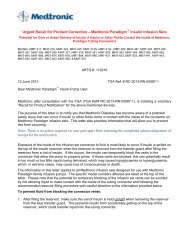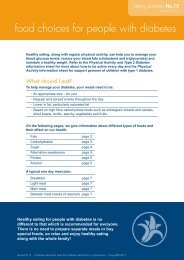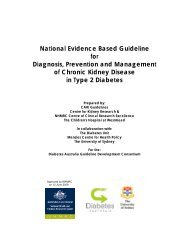Part 6: Detection and Prevention of Foot Problems in Type 2 Diabetes
Part 6: Detection and Prevention of Foot Problems in Type 2 Diabetes
Part 6: Detection and Prevention of Foot Problems in Type 2 Diabetes
Create successful ePaper yourself
Turn your PDF publications into a flip-book with our unique Google optimized e-Paper software.
2.3 Summary <strong>of</strong> RecommendationsRecommendations• People with <strong>Type</strong> 2 diabetes who have peripheral neuropathy should be identifiedbecause they are at risk <strong>of</strong> foot ulceration <strong>and</strong> amputation• People with diabetes should be assessed regularly for peripheral vascular disease• People with diabetes who have had a previous amputation are at high risk <strong>of</strong> ulceration<strong>and</strong> further amputation <strong>and</strong> therefore require regular <strong>and</strong> frequent review• People with diabetes should be assessed regularly to detect foot deformities <strong>in</strong>clud<strong>in</strong>g:• Hallux deformities• Hammer or claw toes• Callus• Charcot’s foot• People with diabetes <strong>and</strong> a current foot ulcer are at high risk for amputation <strong>and</strong>preventative <strong>in</strong>terventions to lower that risk should be <strong>in</strong>stituted promptly• People with diabetes <strong>and</strong> a history <strong>of</strong> a healed previous diabetic foot ulcer should berecognised as hav<strong>in</strong>g a life long <strong>in</strong>creased risk <strong>of</strong> recurrent ulceration <strong>and</strong> amputation• People with <strong>Type</strong> 2 diabetes should be rout<strong>in</strong>ely assessed with the 10g Semmes-We<strong>in</strong>ste<strong>in</strong> mon<strong>of</strong>ilament to detect loss <strong>of</strong> protective foot sensation• People with diabetes should be assessed for peripheral vascular disease by:• enquir<strong>in</strong>g about symptoms <strong>of</strong> <strong>in</strong>termittent claudication• palpation <strong>of</strong> pedal pulses• The rout<strong>in</strong>e surveillance for foot problems <strong>in</strong> people with diabetes should be performed<strong>in</strong> the follow<strong>in</strong>g way:• <strong>in</strong> people without established foot problems, the m<strong>in</strong>imum frequency <strong>of</strong> footexam<strong>in</strong>ation should be once a year• <strong>in</strong> people with at risk feet but without a current active problem, foot exam<strong>in</strong>ationshould be performed every 3 to 6 months• People with diabetes should receive specific footcare education8
















